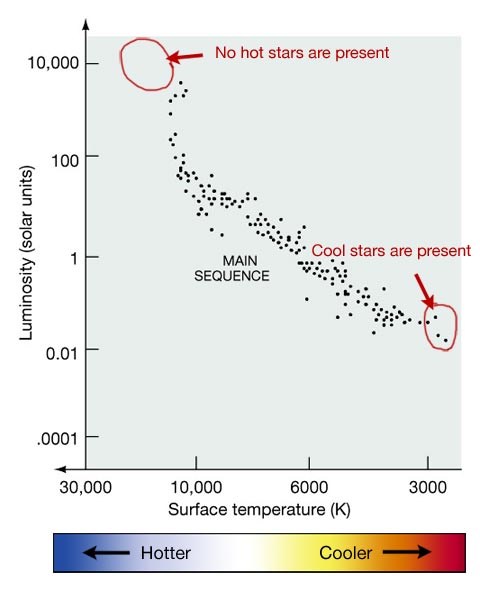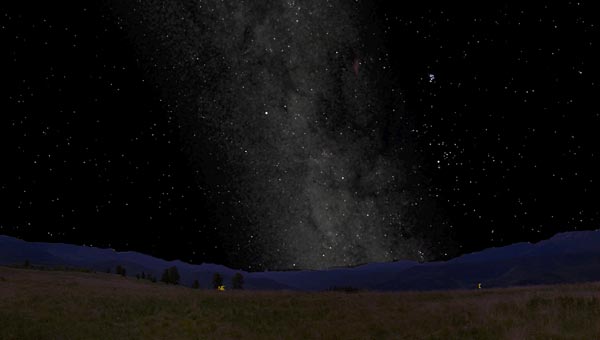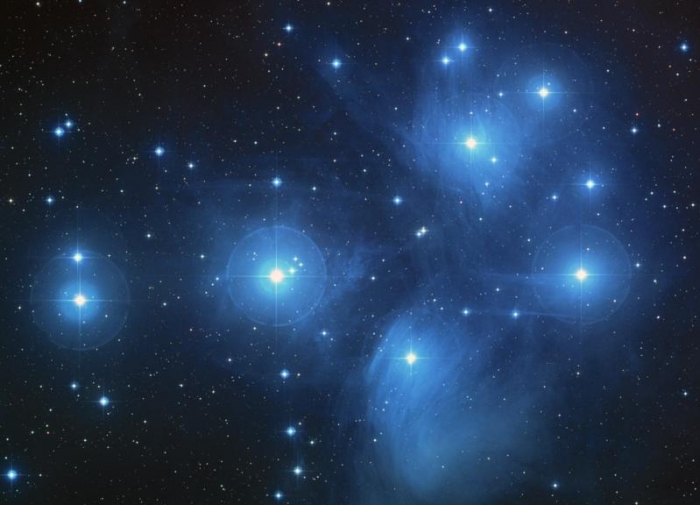Clusters like the Pleiades contain on the order of 1,000 stars. The range of open clusters includes objects with hundreds of stars up to perhaps a few thousand stars. The brightest stars in the Pleiades are B and A Main Sequence stars.
Below is a schematic H-R diagram for the Pleiades. We see that, in this cluster, the Main Sequence includes stars of almost every spectral type, and that only a few stars appear to be evolving or have evolved into Red Giant Stars. In some open clusters, we see that the least massive M-type stars have still not made it onto the Main Sequence. That is, they are still in the process of formation.
Want to learn more?
The Pleiades is a very well studied cluster, and its stellar population is well known to astronomers. However, recall that we have only had instruments powerful enough to observe brown dwarfs since the mid–1990s, so it has only been recently that we have been able to observationally verify that the Pleiades and similar clusters have populations of brown dwarfs, too. For more information, see:
Discovery of brown dwarfs in Chamaeleon by Penn State's Kevin Luhman (then at Harvard)

In the image of the Pleiades, the nebulosity that surrounds the bright stars is very prominent. Recall that these blue regions are called "reflection nebulae," and they are created by the light from the stars scattering off of dust grains in front of the star cluster. This dust is probably a remnant of the molecular cloud that formed the Pleiades. In some other images of open clusters, the stars in the cluster are surrounded by emission nebulae. Astronomers have found that, in general, open clusters do not contain their own gas, but they are often found in the vicinity of gaseous nebulae. Another interesting fact about the location of open clusters on the sky is that they are found to be aligned closely with the "Milky Way," which appears to us from Earth as a patchy band of light on the sky:

Test this with Starry Night!
You can use Starry Night to take a tour of the central part of the Milky Way, which is full of nebulae and star clusters. I have created a .snf file that has the Messier objects in the central Milky Way labeled, too. Many of the labeled objects (for example, M6, M7, M11, M21, M23, and M25) are all open clusters! If you have a small pair of binoculars, you can slowly scan this part of the sky. You will run into open cluster after open cluster.
Many stars in a variety of open clusters have also been studied spectroscopically. The absorption lines in their spectra tell us about the chemical composition of the stars in the cluster. In general, the spectra of stars in open clusters are very similar to the spectrum of the Sun—these stars have chemical compositions and abundances of the different elements similar to those measured for the Sun. Since astronomers refer to elements heavier than helium as a "metal," the astronomical jargon we use is that we say stars in open clusters have "solar metallicity" or are "metal-rich."
